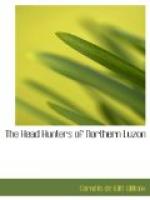Twenty-four hours later we steamed up Manila Bay. The trip was over.
CHAPTER XXV
Future of the highlanders.—Origin of our effort to improve their condition.—Impolicy of any change in present administration.—Transfer of control of wild tribes to Christianized Filipinos.—Comparison of our course with that of the Japanese in Formosa.
The question now presents itself: What is to become of these highlanders of Northern Luzon? And if the answer to be given is here applied only to them, let it be distinctly understood that logically the question may be put in respect of all the wild people of the Philippines. Of these there are over one million in a total population of perhaps eight millions. At once it appears that any conclusions we may draw, any speculations we may cherish, in respect of the Archipelago, as being inhabited by a Christian people unjustly deprived of liberty by us, must be subject to a very large and important correction. Limiting our inquiry to Luzon alone, let it be recollected that of its 4,000,000 population nearly four hundred thousand, or one-tenth, are highlanders, and that these highlanders, in all probability, arrived in the Islands at an earlier date than their Christianized cousins of the lowlands. Let us recollect further that these people are ethnologically not savages at all; not only are they workers in steel and wood, weavers of cloth, but hydraulic agriculturists of the very highest merit. On the side of moral qualities they invite our approving attention: they speak the truth, they look one straight in the eye, they




